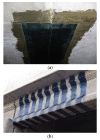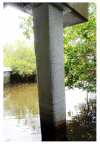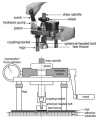Durability of Externally Bonded Fiber-Reinforced Polymer Composites in Concrete Structures: A Critical Review
- PMID: 33671103
- PMCID: PMC7957503
- DOI: 10.3390/polym13050765
Durability of Externally Bonded Fiber-Reinforced Polymer Composites in Concrete Structures: A Critical Review
Abstract
Externally bonded fiber-reinforced polymer composites have been in use in civil infrastructure for decades, but their long-term performance is still difficult to predict due to many knowledge gaps in the understanding of degradation mechanisms. This paper summarizes critical durability issues associated with the application of fiber-reinforced polymer (FRP) composites for rehabilitation of concrete structures. A variety of factors that affect the longevity of FRP composites are discussed: installation, quality control, material selection, and environmental conditions. Critical review of design approaches currently used in various international design guidelines is presented to identify potential opportunities for refinement of design guidance with respect to durability. Interdisciplinary approaches that combine materials science and structural engineering are recognized as having potential to develop composites with improved durability.
Keywords: FRP; civil infrastructure; composites; concrete; degradation; durability; repair; retrofit; strengthening.
Conflict of interest statement
The authors declare no conflict of interest.
Figures



















References
-
- Amran Y.H., Alyousef R., Rashid R.S.M., Alabduljabbar H., Hung C.C. Properties and applications of FRP in strengthening RC structures: A review. Structures. 2018;16:208–238. doi: 10.1016/j.istruc.2018.09.008. - DOI
-
- Meier U., Deuring M. The application of fiber composites in bridge repair—A world premiere at the gates of Lucerne. Str. Verk. 1991;77:534–535.
-
- Meier U. Strengthening of structures using carbon fibre epoxy composites. Constr. Build. Mater. 1995;9:341–351. doi: 10.1016/0950-0618(95)00071-2. - DOI
-
- Karbhari V.M. Durability of FRP Composites for Civil Infrastructure—Myth, Mystery or Reality. Adv. Struct. Eng. 2003;6:243–255. doi: 10.1260/136943303322419250. - DOI
Publication types
Grants and funding
LinkOut - more resources
Full Text Sources
Other Literature Sources
Miscellaneous

